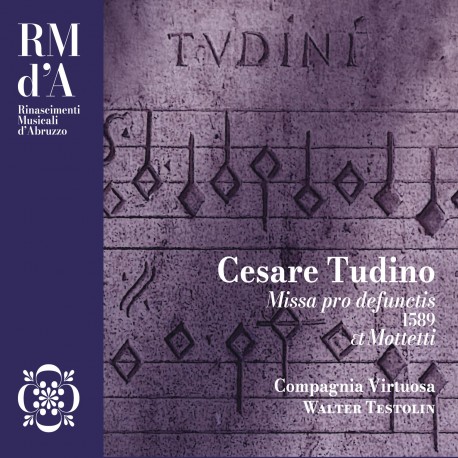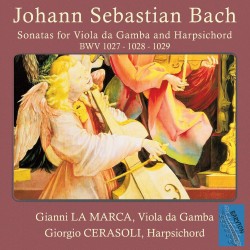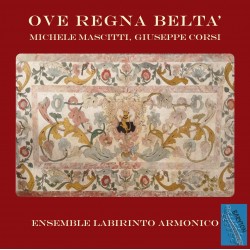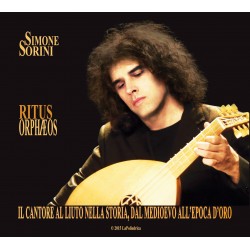No products
Early Music CDs
Top sellers
-

LUCREZIA..... La figlia del papa Borgia 1480-1519
A journey through his life, narrated in the tradition of cantari...
18,00 € Tasse incluse -

CARNIVALESQUE
SEX, LIES AND... MUSICAL TALES Venice, XVIth century The most...
22,00 € Tasse incluse -

JOSQUIN DESPREZ - In Principio
De labyrintho The subject of the present disc are motets by Joaquin that...
16,00 € Tasse incluse -

UN FIOR GENTILE
The ars nova of magister Antonio Zacara da Teramo (ca. 1365-1416)
15,00 € Tasse incluse -

ALLA FESTA LEGGIADRA
Ballate, madrigali e danze all'epoca di Boccaccio (XIV Sec.)
15,00 € Tasse incluse
Viewed products
-

Cesare Tudino - Missa...
CESARE TUDINO (1530 c. - 1591/92)...
Cesare Tudino - Missa pro defunctis, Mottetti
CDA018
New product
CESARE TUDINO (1530 c. - 1591/92)
Compagnia Virtuosa,
Walter Testolin
298 Items
By buying this product you can collect up to 1 loyalty point. Your cart will total 1 loyalty point that can be converted into a voucher of 0,20 €.
More info
Contained in the collection Missae quinque vocum Liber primus published in Venice in 1589, the Missa pro defunctis undoubtedly represents one of the highest artistic achievements of Cesare Tudino, a composer born in Atri in the present province of Teramo, around 1530.
If in our days this Requiem of his had to wait for this recording to become known, the same cannot be said of the years in which the composer worked and in the following decades: evidence of this is its presence in a prestigious manuscript collection (I thank Guglielmo Buonsanti for the report) compiled in 1613 in Augsburg (Augsburg), an important Bavarian economic and cultural center, the city where the Fugger family, the most influential and wealthiest German family of entrepreneurs and patrons, lived and operated. In this collection, titled Offitia Pro fidelibus defunctis a praestantissimis Aucthores composita 4, 5 et 6 vocum, Tudino's Requiem appears alongside versions of the Mass of the Dead by Gregor Aichinger and Christian Erbach, both of whom worked in Augsburg, by Giovanni Matteo Asola of Veneto, and by two veritable giants of the music of the years just past, Orlando di Lasso and Tomás Luis de Victoria. The presence of Tudino's composition, moreover edited a good twenty-four years earlier, shows as much the authority of the composer's figure as the relevance that this Requiem had even outside Italy in the years between the end of the sixteenth and the beginning of the seventeenth centuries.
From its opening, the introit Requiem aeternam, Tudino's mass shows the very high level of the composition. Here the slow and steady flow that lines the cantus firmus entrusted to the Tenor's voice gives rise to a kind of transparent magma, mottled with small rhythmic movements of the voices: a masterful writing, capable of enhancing the sense of trust and light that the text evokes, in one of the most beautiful musical pages of the Italian Renaissance.
Alongside moments in which the compositional wisdom of the Atrian master gives life to strongly assertive episodes, such as Kyrie, Sanctus and, in a slightly more nuanced way, Agnus Dei and Lux aeterna, two long pieces stand out for particularity within the work: the first is the long Dies irae sequence, composed on three different patterns repeated in turn three times, which are alternated with plainchant verses, before concluding in the moving trio Judicandus homo reus, which turns to the tender seal of the last stanza Pie Jesu Domine; the other episode is the offertory Domine Jesu Christe, a long motet of powerful emotional tension and of particular difficulty in execution, in which music and text become entangled in a vortex that well recalls that descent into the dark into which the soul of the deceased is in danger of slipping if not sustained by the prayer of those who are accompanying it on its final journey.
In the 1589 printing, the Requiem concluded with a motet, Ego sum resurrectio et vita, a text that is not part of the liturgy of the dead but which well represents the meaning of the entire rite for a believer. That inner light that the Introit had evoked is eloquently manifested in this piece, almost festive in character, a true testimony to Tudino's magisterium. Worthy of note, in a composition of such exemplary serenity, is the almost madrigal-like passage in which the music, first masterfully suspended and rhetorically rendered through a three-voice writing in false bordone on the words “etiam si mortuus fuerit,” suddenly explodes in the subsequent “vivet in aeternum,” where the voices chase each other in rapid successions of black notes.
In addition to the Missae quinque vocum, Ego sum resurrectio et vita was already present in the collection Mottettorum quinque vocibus Liber primus published a year earlier, also in Venice, in 1588, from which the other six motets appearing in this recording are taken.
For one of them, O memoriale, we chose to entrust an organ tablature of it elaborated and performed by Dario Carpanese.
Regina coeli is a festive motet that offers close imitation writing that alternates syllabic phrases with more flowery ones. Hodie nobis de coelo right from the transparent and very successful melodic opening that characterizes its own beginning, is a motet of remarkable quality that seems somehow indebted to Palestrina's style.
Beautiful are the three motets that close the recording.
Pater noster is a motet of limpid construction and very high workmanship that is inspired precisely by that Palestrina style, made up of phrases that dissolve one into the other seamlessly. Only a few words, (“da nobis hodie,” “in tentationem,” “sed libera”) stand out thanks to a suddenly vertical writing, acquiring particular importance, enhancing by contrast the fluidity that characterizes the others.
Da pacem Domine, the beginning of which seems to reflect fragments of that chromatic experimentalism to which Tudino had given shape in some of his madrigals, is a motet of high dramatic and expressive tension and equally high technical level.
The grace evoked in the text, on the other hand, is the stuff of which the concluding O sacrum convivium is composed, a motet of luminous beauty in which the composer's craft is sublimated into a truly commendable sonic result: like the previous motets, it too, in some ways indebted to Palestrina, has little to envy from many of the works of the great Prenestine master.
One can easily conclude from listening to these compositions that the quality of Tudino's music has little to envy that of the great names of the Italian Renaissance, and this disc is intended to be only a first step toward a greater knowledge of a misunderstood name in the music of our past. It is a representative testimony to the many musical talents that that era expressed, even and especially far from the great centers, a widespread diffusion of musical art that flourished throughout the peninsula and of which Cesare Tudino is a particularly tasty fruit, but certainly not an isolated one.
Walter Testolin (translation by Walter Pili)
The Tudino Project is an initiative dedicated to the rediscovery and promotion of late Renaissance music in Abruzzo.
Conceived and promoted by the Compagnia Virtuosa cultural association since 2022, the project involves the collaboration of regional and national associations, researchers and scholars in the field, as well as the support of public and private institutions and organisations, creating a network of synergies between the parties involved.
The multiannual programme includes a series of initiatives aimed at promoting knowledge of this musical heritage through concerts, workshops, seminars, research and publications. All with a popular slant, combining historical research with musical practice, creating learning opportunities and encouraging participation and interest in early music.
Musical ‘renaissances’ of Abruzzo is a record collection which, as part of the "Tudino Project", aims to present, through monographic volumes (by theme or by author), a selection of works by illustrious Abruzzian composers of the historical period, but little or not known today, in order to promote their knowledge and enhance their musical heritage.
Rinascimenti" stands for "rebirths", a term that well expresses the idea of giving new life to artists who, although marginal compared to the great musical centres of the time, contributed significantly to the evolution of music by establishing or developing new styles.
The series is open to new contributions and the project is ambitious: Capece, Sabino, Fornaci, Lupacchino, Aglione, Johannes de Quadris and Cotumacci are some of the names that will make up the collection.
Not only a tribute to the Renaissance, but a tool for a true rebirth of Abruzzo’s historical musical heritage.
Walter Pili
Reviews
No customer reviews for the moment.
21 other products in the same category:































